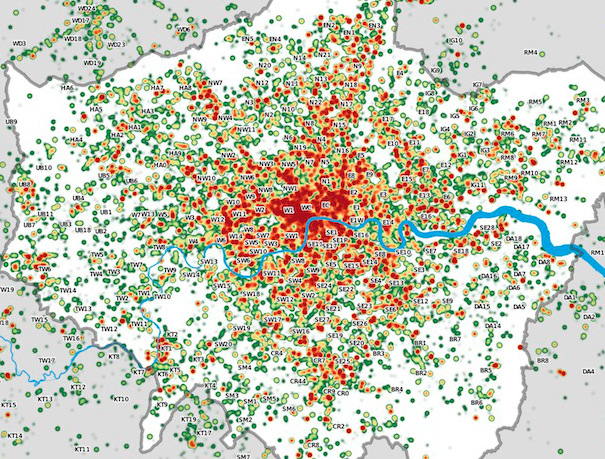
I was at a talk last night organised by the Londonist – Magical Maps. It took place in the TAG Fine Arts‘ Air Gallery in Mayfair. TAG Fine Arts currently have an exhibition there – The Art of Mapping, and the audience was surrounded by the various artworks – some made from maps, some as interpretations of maps and some simply with a geographical theme.
The speakers were Stephen Walter, an artist who drew the “Island” London map that was a hit at the British Library’s recent Magnificent Maps exhibition; John Kennedy, a London cabbie, blogger and chronologer of bollards and other London objects; and UCL CASA’s very own James Cheshire, recent PhD, now lecturer.
James was up first and showed some of the recent visualisation work by CASA. You can see most of what he showed in an article here.

Then John explained The Knowledge, taking the audience on a verbal taxi journey, from the gallery to the Elephant and Castle – “the true centre of London” – and back, taking into account various banned turns and other taxi restrictions! His journey was peppered with anecdotes of the various places encountered.
Finally, Stephen outlined his artistic career, showing how he switched from traditional photography and painting, to producing the monochromatic repeated symbols on landscapes, that envolved into maps and finally his famous Island map. He also showed some works in progress, such as a map of London’s underground structures (tube lines, water pipes, the Mail Rail etc).

Matt from the Londonist then chaired a Q&A session with the panel, and finally there was another chance to look around and think about the artworks on the walls. I was most intrigued by the below image, which lists and shows all the bridges across the Thames in London, the top line being Teddington Lock and the bottom being the Thames Barrier – but I don’t know why the lines cross over and wiggle. Perhaps it is just purely artistic, but the data visualiser in me hopes there is a deeper meaning and an embedded infographic…

An excellent evening with three very different but equally engaging speakers and some very interesting things to look at.
The exhibition is open for another week, it’s quite small and free, and there is a complementary exhibition book, so take a visit to Mayfair and have a look! There is a talk tomorrow by some of the artists.







 The exhibition is in three main sections – downstairs there are a number of big screens, showing the aforementioned animations. The area is quite dark, so the graphics have come out really well. The second section is up a spiral staircase (easy to miss) where a number of touch-screen computers show more visualisations from CASA and others, each selectable by the user. The system that runs this will allow us to update the animations during the course of the exhibition, so if we do some newer related work, you may well see it here! Behind this is the last section, which is more conceptual, with a number of “visions of the future from the past” magazine covers, and other bits of futuristic transport technology – a Sinclair C5 and a “Ryno” one-wheeled motorbike. Sadly a Barclays Cycle Hire bike is not there in the flesh, but you
The exhibition is in three main sections – downstairs there are a number of big screens, showing the aforementioned animations. The area is quite dark, so the graphics have come out really well. The second section is up a spiral staircase (easy to miss) where a number of touch-screen computers show more visualisations from CASA and others, each selectable by the user. The system that runs this will allow us to update the animations during the course of the exhibition, so if we do some newer related work, you may well see it here! Behind this is the last section, which is more conceptual, with a number of “visions of the future from the past” magazine covers, and other bits of futuristic transport technology – a Sinclair C5 and a “Ryno” one-wheeled motorbike. Sadly a Barclays Cycle Hire bike is not there in the flesh, but you 



